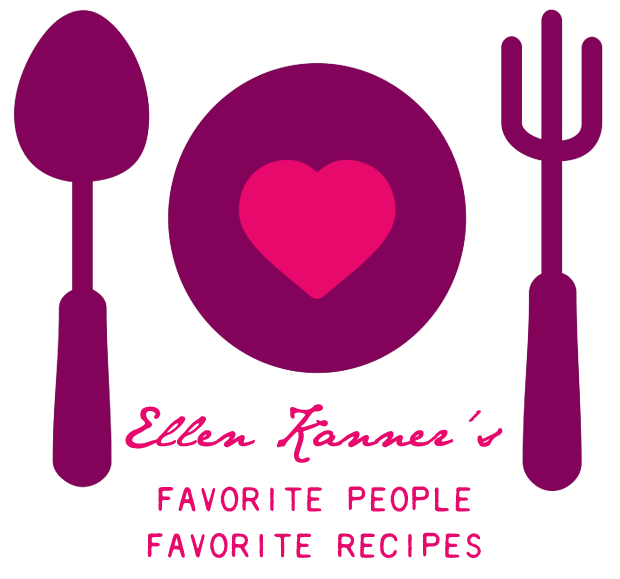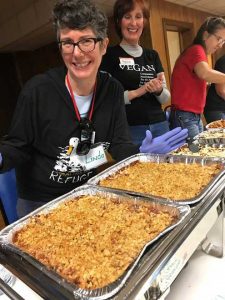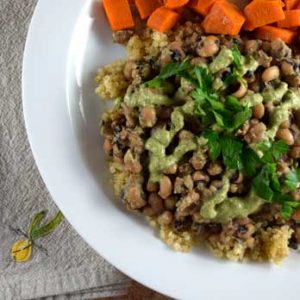
As Hurricane Florence made landfall in the Carolinas, I contacted Cook for Good’s Linda Watson and urged her to stay safe. Her My Favorite People, My Favorite Recipes guest post could wait for a better time. Linda came through anyway, despite rising flood waters, her local environmental advisory board meeting and hosting a screening of Michael Moore’s Fahrenheit 11/19. So you can see why I’m Linda’s fan. I’ve been a fan since we met, bonded over the power of fundamental home cooking and I learned about Cook For Good. On her website, in videos, books and classes, Linda combines free vegan, organic recipes with basic, long-lost home economics skills. The result? “Save money, eat well, make a difference.“ She’s the evangelist of empowering everyone to cook for good. I’m super-proud of her and super-proud to share her guest post.

Linda Watson update for Ellen Kanner September 21, 2018 (Thanks, Ellen!!!)
It’s easy to feel helpless during these days of extreme weather and extreme politics. With Hurricane Florence barely out of North Carolina, I take comfort in knowing that I’m part of a growing movement that makes a difference with every meal.
What We Eat Affects the Climate
What did I try to focus on as the winds roared around my house last week?
• Plant-based diets produce less greenhouse gas than ones heavy in meat and dairy. The ocean could have been warmer and the air more saturated with moisture if I’d stuck with the Standard American Diet.
• News flash: plant-based diets don’t involve animals. My heartbreak over the 5,500 pigs and 3.4 million chickens who died in the storm was leavened a bit with the knowledge that none of them were there to feed me.
• No animals, no animal waste. My grocery money didn’t pay for the factory-farm buildings, hog-waste lagoons, and meat-packing plants that polluted the flood waters, spreading disease and stink.
Even in perfect weather, life sucks when people treat you as a machine for producing meat, milk, or eggs. Recent lawsuits in North Carolina revealed that pig farms make their human neighbors miserable and sick too. Usually, these neighbors are low-income people of color.
How Going from Vegetarian to Vegan Rocked My World
I started the Cook for Good project to help people explore the benefits of eating a super-thrifty vegetarian diet. It’s good for your wallet, your health, your community, and the environment. After a summer on variations of the Food Stamp Challenge, I wrote my first book, Wildly Affordable Organic: How to Save Money, Eat Well and Make a Difference – on Five Dollars a Day or Less.
A few months after the book came out, a friend convinced me that vegetarian was not enough. You know he was very persuasive because he did this at a Christmas pizza party! Danny had just recovered from his fifth heart attack. His doctor told him the only hope was to adopt a strict plant-based diet as T. Colin Campbell recommended in The China Study.
I had my last cheese pizza at that party. Then I stayed up until 3 am reading The China Study. My friend was right! When my husband woke up the next morning, I told him we were going vegan.
The results shocked and delighted me. I soon felt fifteen years younger. I could walk up steep hills without huffing and puffing anymore. My arthritis disappeared within a month. Nearly eight years later, I still haven’t had one of my “normal” migraines – avoiding close to 50 days of blinding pain.
Of course, I shared my new cooking style with Cook for Good readers. My 21-Day How to Go Vegan online retreat helps people take the plunge or stay the course. The sessions got rave reviews from the people who joined me. Starting this week, you can take it whenever you like. I’m now working on my next book: Wildly Affordable Vegan. It will feature recipes for food I didn’t know how to make at first, such as eggless banana bread, sumptuous cashew lasagna, and chocolate-hazelnut gelato.
Plants and Politics
Being vegan isn’t just about what you eat. Many of us no longer wear leather, wool, or silk. I hope more of us will vote and advocate politically. Politics gives us a way to protect each other and other beings on a large scale. We can elect officials who will help reverse our climate catastrophe. It’s a chance to avert enormous suffering. As California just demonstrated, politicians can ensure that every hospital patient has a healthy vegan option at every meal.
Issues matter too. For example, this November North Carolinians will decide if hunting and fishing should be a constitutional right. (Ai yi yi!) The amendment would also make public hunting and fishing the “preferred method of managing and controlling wildlife.” This unneeded amendment is bait for pro-hunting voters and could stop future environmental protection.
Non-elected officials can make a difference too. Check out your local advisory boards and citizens groups. They give you a chance to contribute and to gain experience if you ever want to run for office. As a member of Raleigh’s Environmental Advisory Board, I raise awareness of the climate impacts of our food choices and how our events would be healthier and more welcoming if they offered plant-based options. Many people can’t or won’t eat pork or other meat, shellfish, eggs, or dairy.
There are many ways we can reduce suffering for ourselves and others. Please vote with your fork and vote with your vote. Together, we can make a difference.
Lucky Lemon Black-Eyed Peas
by Linda Watson of Cook for Good from her upcoming book, Wildly Affordable Vegan. Legend has it that eating black-eyed peas on New Year's Day brings luck. Who couldn't use some luck year round? Some years, I make this dish for my birthday in March. It's quick to make but rich in flavor layers. A bay leaf enhances the earthiness of the black-eyed peas. Walnuts add creamy umami to the bright sauce. Serve Lucky Lemon Black-Eyed Peas over hot cooked quinoa, rice, or cornbread. For a fat-free version, skip the olive oil. You'll have some extra sauce to serve over baked potatoes or roasted vegetables. Why? The blender or food processor needs enough material to get a grip. Also, a key Cook for Good tenet is to cook once and enjoy twice.Ingredients
- 1 pound dried black-eyed peas 2 generous cups
- 1 bay leaf
- 1 teaspoon salt
- water to cover
- 4 cups water
- ½ cup walnut pieces
- 1 clove garlic
- 2 tablespoons lemon juice juice from one medium lemon
- 2 tablespoons olive oil
- handful of fresh parsley leaves and stems about ¾ cup
- ¼ cup broth from cooked black-eyed peas
- ½ teaspoon salt or to taste
Instructions


Leave a Reply